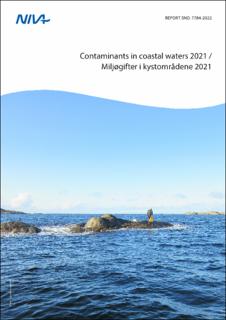Contaminants in coastal waters 2021 / Miljøgifter i kystområdene 2021
| dc.contributor.author | Schøyen, Merete | |
| dc.contributor.author | Grung, Merete | |
| dc.contributor.author | Lund, Espen | |
| dc.contributor.author | Hjermann, Dag Øystein | |
| dc.contributor.author | Ruus, Anders | |
| dc.contributor.author | Øxnevad, Sigurd | |
| dc.contributor.author | Beylich, Bjørnar | |
| dc.contributor.author | Jenssen, Marthe Torunn Solhaug | |
| dc.contributor.author | Tveiten, Lise Ann | |
| dc.contributor.author | Håvardstun, Jarle | |
| dc.contributor.author | Ribeiro, Anne Luise | |
| dc.contributor.author | Doyer, Isabel | |
| dc.contributor.author | Bæk, Kine | |
| dc.date.accessioned | 2023-01-23T07:54:35Z | |
| dc.date.available | 2023-01-23T07:54:35Z | |
| dc.date.created | 2023-01-19T15:00:09Z | |
| dc.date.issued | 2022 | |
| dc.identifier.isbn | 978-82-577-7520-9 | |
| dc.identifier.issn | 1894-7948 | |
| dc.identifier.uri | https://hdl.handle.net/11250/3045116 | |
| dc.description | Prosjektleder Merete Schøyen | en_US |
| dc.description.abstract | The Norwegian environmental monitoring programme “Contaminants in coastal waters” (Miljøgifter i kystområdene - MILKYS) examines levels, trends, and effects of contaminants in biota. The 2021 investigation included analyses of more than 180 different contaminants or biological effect parameters in five species (blue mussel, cod, dogwhelk, common periwinkle, and common eider). The contaminants measured include metals, TBT, PCBs, PAHs, PBDEs, PFAS, HBCDs, chlorinated paraffins, siloxanes, and pesticides. Biological effect parameters investigated include imposex (VDSI) and intersex (ISI), PAH-metabolites, ALA-D, and EROD. In this report, 27 contaminants and in addition, biological effect parameters were chosen for in-depth presentation. EQSs (environmental quality standard) were exceeded in samples of blue mussel (21%), cod (36%), and eider (23%). Contaminants above EQSs were sumPBDE6, mercury (Hg), sumPCB7, and fluoranthene. PROREF (Norwegian provisional high reference contaminant concentration) was exceeded for 35% in blue mussel and 11% in cod, and exceedances were higher in mussel (up to >20x PROREF) than cod (2-5x PROREF). Even though decreasing time trends dominated both long-term (>10 years) and short-term (≤ 10 years) where trends could be detected, notably increasing trends were observed which are discussed here. Notably increasing short-term trends for blue mussel were lead (Pb), chromium (Cr), arsenic (As) and some PCBs, and for cod were mercury (Hg), and silver (Ag). | en_US |
| dc.description.sponsorship | Miljødirektoratet | en_US |
| dc.language.iso | eng | en_US |
| dc.publisher | Norsk institutt for vannforskning | en_US |
| dc.relation.ispartof | NIVA-rapport | |
| dc.relation.ispartofseries | NIVA-rapport;7784-2022 | |
| dc.relation.ispartofseries | Miljødirektoratet-rapport;M-2362/2022 | |
| dc.subject | Miljøgifter | en_US |
| dc.subject | Environmental pollution | en_US |
| dc.subject | Norge | en_US |
| dc.subject | Norway | en_US |
| dc.subject | Marint og kystvann | en_US |
| dc.subject | Marine and coastal water | en_US |
| dc.subject | Biologiske effekter | en_US |
| dc.subject | Biological effects | en_US |
| dc.title | Contaminants in coastal waters 2021 / Miljøgifter i kystområdene 2021 | en_US |
| dc.title.alternative | Contaminants in coastal waters 2021 / Miljøgifter i kystområdene 2021 | en_US |
| dc.type | Research report | en_US |
| dc.description.version | publishedVersion | en_US |
| dc.rights.holder | © Norsk institutt for vannforskning/Norwegian Institute for Water Research & Norwegian Environment Agency The publication can be cited freely if the source is stated | en_US |
| dc.subject.nsi | VDP::Matematikk og naturvitenskap: 400 | en_US |
| dc.subject.nsi | VDP::Mathematics and natural scienses: 400 | en_US |
| dc.source.pagenumber | 176 | en_US |
| dc.source.issue | 7784-2022 | en_US |
| dc.identifier.cristin | 2110572 | |
| dc.relation.project | 210200 | en_US |
| cristin.ispublished | true | |
| cristin.fulltext | original |
Tilhørende fil(er)
Denne innførselen finnes i følgende samling(er)
-
NIVA-rapporter [7006]
-
Publikasjoner fra Cristin - NIVA [2160]
